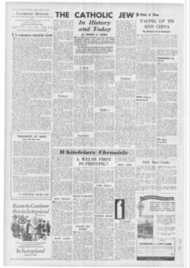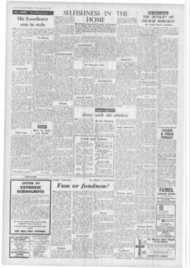Page 9, 11th January 1963
Page 9

Report an error
Noticed an error on this page?If you've noticed an error in this article please click here to report it.
Tags
Share
Related articles
Escape Route Blocked For Fleeing Popes
The Voice Of The Vatican
Necessary A.r.p. In The Vatican
New Building To Oust Sistine
Hill-top Hideaway Found By Marines
ROME 'ESCAPE LINE' RESTORED
By MARIAN CURD
AROME "escape line" of the 13th century—an ancient covered passageway running along an old wall from the Vatican to Castel Sant'Aneelo—has been restored, announced Vatican authorities this week. And the bullet
holes have been left unfilled.
The astonishing thing is that few visitors to Rome ever notice this tall, straggling wall towering high above the streets. Roman and pilgrim alike scarcely give it a thought as they dash out of St. Peter's Square and through one of the wall's rather dreary arches to catch their bus . . .
But it is a wall steeped in history. Ns most famous tale concern. Pope Clement VII who, one terrible morning in May, 1527. had to use its passageway as an escape route from the hordes of mercenaries then invading Rome under Charles V.
MASSACRE
The Pope had resolved to meet the sackers with dignity, robed and seated upon his throne in St. Peter's itself. But news that cutthroats had broken into the hospital of S. Spirit° and slain all the patients, followed by the sound of the cannons on the steps of the Basilica itself, quickly changed the Pope's mind. The Swiss guards down in the Square were dying to a man as the Pope, accompanied by a Cardinal and with his cloak flung over his head and shoulders to avoid being sniped at, fled along the corridor
o the castle. This was also the terrible occasion when in the crush of refugees one Cardinal was almost trampled to death, another was pushed through a window and a third was hauled up the ramparts in a basket. Unspeakable horrors and barbarities occurred during the eight-day sacking of the city by the more than 40,000 crazed ruffians.
The Pope reached the castle where, with 90 Swiss, 400 Italians. and 13 cardinals, he lived, with very little food, in a state of seige. Romans found trying to pass food to them were shot, An old woman who took some salad for the Pope was hanged.
Several months later the Pope left Rome disguised as a market
gardener. His humiliation was completed the following year when he crowned Charles as Emperor. For years past the wail (and its tunnel) have remained almost untouched as crumbling, gloomy reminders of a turbulent past. An officer of the Swiss Guard has held the key; but dirty and abandoned, the corridojo di Castello has remained closed to visitors.
Workers of the Vatican's technical department have now cleared the rubble, inserted new stones, plastered the passageway, and installed electric light. The project is all hut complete. Only a short section nearest the castle remains unrepaired. Reason: Discussions as to who should pay for the cost of that section, the Vatican or the Italian government, have not yet been resolved.
The Castel Sant'Angelo, built by Hadrian about 135 a.d. for his own tomb, was then much more enormous than it is today. In fact the remaining building is a very small portion of the original marble and bronze covered mausoleum which was 100 yards long on each side.
The Castle itself has a history almost as gloomy and sinister as the Tower of London. It was successively mausoleum, fortress, prison and palace.
It got its present name during the reign of Pope Gregory the Great. Half Rome had died of plague. The Pope, assembling the people each morning at dawn led them into St. Peter's singing the Kyrie Eleison.
The plague did not stop. So, Gregory ordered a procession in which he carried the famous picture of Our Lady traditionally painted by St. Luke.
The plague ceased. the air became pure and clean. Angelic voices were heard singing the Regina Coen. At the same time Pope Gregory saw an angel standing over the Castle sheathing his sword. Gregory understood by this that the pestilence was passed and so the Castle became the Castle of the Angel.
blog comments powered by Disqus











